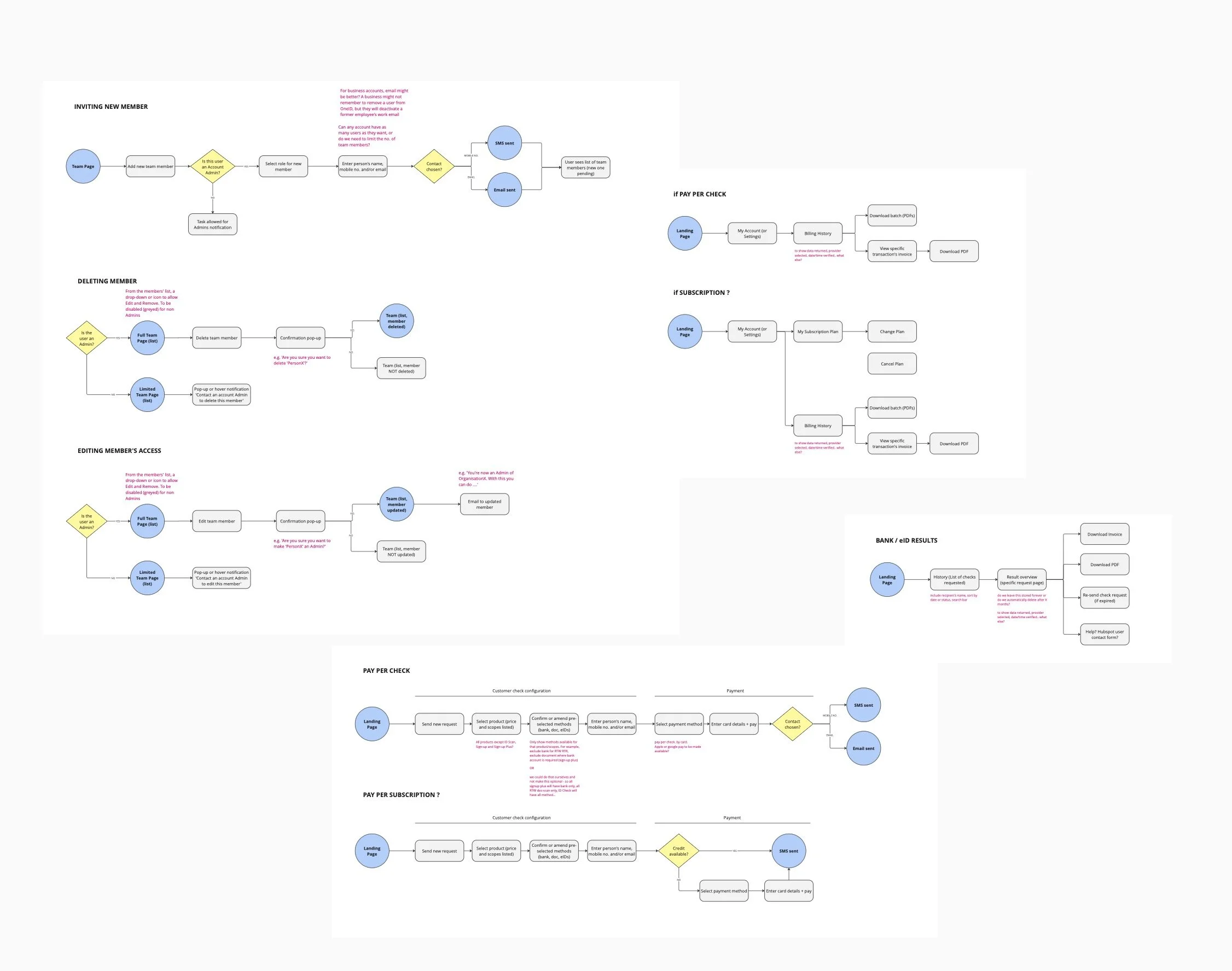No-Code Portal
MVP Studies: Exploring Passive Revenue for SMEs
Read time: 8 minutes
OneID enables businesses to verify customer identities securely. This project aimed to empower registered companies to request identity checks directly from their customers without complex integrations.
Team size
Product team size 6; Sole designer
Role
Sole UX Designer
Skills & Tools
Cross-functional collaboration with Sales
MVP prioritisation
Sitemaps & User flows
Figma prototype
Impact
Reimagined a new, passive way of generating revenue.
Defined MVP requirements.
The problem
Many small businesses wanted to integrate OneID but lacked the developer resources to work with our API. Onboarding them required heavy support from our team, slowing adoption and limiting scalability.
We needed a way for non-technical users to set up and manage identity checks without depending on engineering support.
Solution
I proposed and designed a self-service, no-code portal. This would allow businesses to:
Send secure identity verification requests directly to their customers.
Use a PAYG model with minimal friction.
Track responses and view results in a clear, actionable dashboard.
The goal was to reduce onboarding friction and unlock a new, scalable revenue stream for OneID.
Collaboration
This project was shaped by close collaboration with the Sales team, who act as the frontline channel of customer feedback. Their insights into customer pain points and market gaps informed the requirements from day one.
Sales brought knowledge of new customer struggles (cost, integration complexity).
I translated these insights into UX opportunities, framing a lightweight, no-code portal.
We worked iteratively to ensure the prototype aligned with market demand and commercial strategy.
This collaboration ensured that the portal was not just a design exercise, but a business-aligned solution that can bring passive revenue with little maintenance.
Process
Discovery: Gathered insights from SMEs, support teams, and sales conversations to understand barriers for non-technical customers.
MVP definition: Collaborated with Product and Engineering to scope requirements, ensuring the build could be tested quickly with early adopters.
Prototyping: Designed and tested interactive flows in Figma to validate usability and feature priorities.
Iteration: Adjust based on usability testing and internal stakeholder feedback, ensuring clarity for first-time users.
Research & Insights
Internal research & workshops: Collaborated with Sales, Customer Solutions Manager, and Product Analyst to identify the information businesses need both to operate effectively and to remain compliant.
For businesses: visibility on request status and transaction details, pending actions, ease of creating/sending requests, ability to download results, visual clues to help assess risk.
For compliance: verification trail, customer verified details, fraud markers (identity fraud score, SIRA checks, Amberhill match), . clear record-keeping, evidence log, audit history.
Insights from workshops with Sales, Customer Solutions Manager, and Product Analyst defined the dual focus of the MVP: enabling business visibility while meeting compliance requirements.📌 Insight: While stakeholders suggested richer features like progress diagrams and advanced dashboards, these were not included in the MVP requirements. Instead, we deliberately chose to build a lean proof of concept, focusing on the minimum needed to test adoption and gather real-world feedback. This approach allowed us to optimise development time and costs, ensuring we delivered the right level of refinement at the right time — rather than over-investing before validating the market need.
UX Strategy
Position the portal as a frictionless entry point for smaller companies.
Balance simplicity (proof of concept) with scalability (future features).
Ensure clarity and trust for both business users and their customers, with transparent communication on security and compliance.
Enable a low-risk adoption path by offering companies an initial allocation of five free checks. This allows them to test the product quickly in production before committing developer resources to sandbox integration.
Design & prototyping
Flows created:
Business logs in → lands on dashboard.
Reviews activity list → sees different requests and their statuses.
Creates and sends request → customer receives SMS or email.
Customer completes secure verification flow (click here for case study).
Business accesses results → comprehensive identity report is available in the portal.
These flows were designed with a focus on core MVP functionality, enabling us to launch quickly, gather real-world insights, and iterate based on customer feedback.
Dashboard
Purpose: Give businesses a quick overview of required actions and latest results.
Key MVP features:
Display of results that hasn’t been actioned;
Recent results and statuses.
Simple entry point to create new requests.
Activity
Purpose: Provide a chronological log of requests.
Key MVP features:
List of requests with statuses (Initiated, Passed, Flagged, Pending Expired).
Ability to filter and find specific requests by status or action.
Ability to sort list by date.
Identity Report
Purpose: Balance business visibility with compliance requirements, re-using data return formats already built for API integrations..
Key MVP features:
Include all data points identified during cross-team workshops (business + compliance needs).
Use the same data structure and format as existing direct API integrations, ensuring consistency across OneID’s products.
Automatic deletion notice to inform users when the report will no longer be accessible.
Ability to download reports as PDF and to delete when required, supporting both usability and compliance.
Introduce simple “Action” states (e.g., To-do or Closed) so teams can manage the status of each verification.
Proof of Concept Launch
Reflection
Designing for non-technical users challenged me to simplify flows without losing compliance rigour. Early feedback showed businesses appreciated the clarity and independence the portal provided.
However, due to a business redirection toward enterprise customers, we decided to pause the no-code portal for now. The project remains an important opportunity we hope to revisit once scalability challenges and enterprise priorities are addressed.
If I continue iterating, I’d focus on:
Measuring time saved in onboarding compared to API integrations;
Tracking adoption rate among SMEs;
Portal ‘stickiness’;
Exploring integrations with payment systems to extend value.




